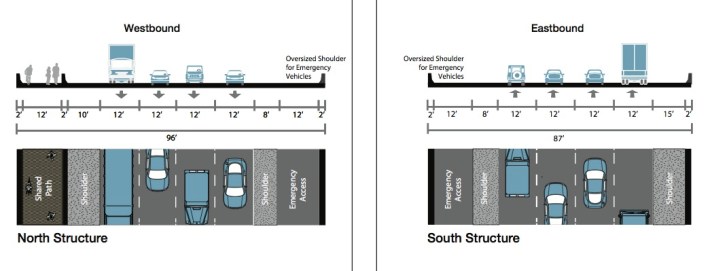
The Cuomo administration's plan for the new Tappan Zee Bridge, described in yesterday's draft environmental impact statement, is more than a missed opportunity to provide New Yorkers with faster and greener commutes using transit. It also foreshadows a potential environmental disaster, as the state prepares to spend huge sums on a span that can funnel much more traffic than the current bridge.
The new Tappan Zee will be more than twice as wide as the existing one. While the state government says the new bridge will carry the same amount of traffic as today's bridge, the designs in the DEIS include enough pavement to carry far more cars, which could lead to more pollution and more sprawl, and will certainly incur hundreds of millions of dollars in unnecessary spending. The one silver lining is that a more transit-friendly administration could use the extra space to add bus rapid transit service in the future.
Together, the two spans of the proposed Tappan Zee Bridge would measure a full 183 feet across, while the current bridge is 91 feet wide. Where the current bridge has seven travel lanes, the new bridge will have eight. A shared bicycle/pedestrian path adds a few more feet. But the lion's share of additional asphalt comes from the addition of wide shoulders bracketing the traffic lanes in each direction, and an additional "emergency access" lane in each direction.
The reason to make the bridge so incredibly wide, according to the DEIS, is to ensure that either span on its own can carry as many cars as the current bridge, in case one span has to close for whatever reason. "In the event that an incident or extreme event would require the closure of one structure, the second structure could remain open to traffic," reads the DEIS. "To provide adequate capacity for such short-term traffic operations, each of two road decks would need a minimum width of 87 feet to provide for a minimum of seven temporary highway lanes, shoulders, and an adequate buffer for two-way traffic operations."
The extra lanes are an extraordinary concession to the automobile, predicated on the idea that we should build roadways so that even a rare disaster won't cause any reduction in traffic capacity.
Building each span with the full capacity of the existing bridge -- up to 14 total lanes, if need be -- is incredibly costly. A back-of-the-envelope calculation by Streetsblog based on the state's 2006 financial numbers puts the cost of the emergency access lanes at around $825 million, or about one-sixth of the entire project budget.
Emergency lanes are unheard of on even the newest bridges. On the Port Authority's planned Goethals Bridge replacement, Minnesota's I-35 Bridge over the Mississippi River, Oregon's proposed Columbia River Crossing, and California's new Bay Bridge, no such emergency access lanes exist, only shoulders.
The DEIS suggests that the "emergency access" lanes won't be set in stone: "The additional width, however, could be converted to HOV or BRT lanes in the future if appropriate studies deemed this corridor and alignment appropriate. If this conversion did take place in the future, emergency access could revert back to the use of the full shoulders."
In other words, the space set aside for "emergency access" is primed to be converted into extra capacity: The only question is whether that will end up being used for buses or for cars. If a future administration wanted to run bus rapid transit across the Tappan Zee, the emergency lanes would provide space to do so. However, if a future administration instead caved in to motorists complaining of congestion and opened up the space to private automobiles, even carpoolers, the result would be more driving and more of the pollution and sprawl that comes with it.
There's a long history of state DOTs taking spare room on highways and converting it into traffic lanes. Private vehicles have been allowed onto shoulders, sometimes only during rush hour, in Massachusetts, Virginia, Washington, Hawaii, Florida, and Minnesota, according to the Federal Highway Administration. The ability to turn "emergency lanes" into traffic lanes might be too tempting for New York State DOT to pass up. Quite recently, NYS DOT gave in to political pressure and let carpoolers use the bus lane on the Staten Island Expressway.
The State DOT has not replied to Streetsblog inquiries about the emergency lanes.
The problem with Cuomo's Tappan Zee blueprint isn't just that it preserves the transit-free status quo. Under the Cuomo plan, New York might be left with a bridge that's ten lanes or wider, where it used to have a seven-lane bridge -- a major commitment to continued car dependence. A future with no new transit is bad enough -- Cuomo is also poised to spend huge sums on a project that could easily generate more traffic and sprawl.





